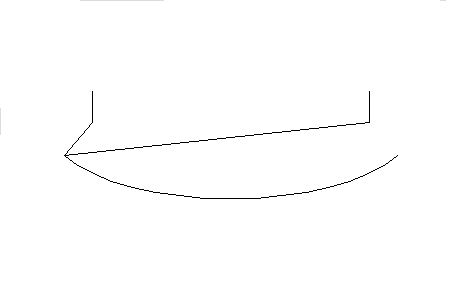Building a Stage:
Something that really finishes off a home theater is a stage in the front. Sort of gives the whole room a different "feel" or sense of drama. While a nice enhancement to a theater, you need to be careful that you do it right, or you may have a giant resonating cavity once that subwoofer starts in.
The general plan is to have a rectangular "deck", that runs the width of the room. The stage comes out from the front wall about 2' to 4' usually. The stage is often installed with a radius front, generally 2/3 of the overall width of the stage itself.
The stage is built using 2x4s or 2x6s as "joists". The 2x4s or 2x6s that lay on your floor could use a little damping (de-coupling). The theory there is that the sound transmitting through the 2x4s won't make it to the concrete floor very well if the underside of the 2x4s are de-coupled a bit. I'd apply two beads of caulk (3/8") to the underside of these 2x4s where they will contact the floor. Let the caulk cure before installing, perhaps a day or two. Apply a heavy bead of construction adhesive in an "s" pattern over and between the cured caulk beads when installing. Make sure the floor is very clean to get good adhesion. This little process will de-couple the 2x4s somewhat, so that their vibrations won't tend to transmit into the floor. Use this technique with all of the framing members of the stage. Now the frame of the stage is "floating" on these beads of cured caulk.
The Radius front: A very neat radius front can be created, again using 2x4 (2x6) pieces with two layers of 1/8 tempered hardboard to bend and form the curve. The two (or more) layers of curved hardboard are glued to one another. Solid as a rock. The 2x4s give it strength, while the hardboard is a nice radius. Neat as hell.
How to draw the radius curve. This will take a little playing around with to get it the way you want it. It'll take more effort to describe this without a picture. First of all, the stage is framed (see below) before the radius is drawn and built.
Let's say your stage is 14' wide. You might like a radius that is 10' wide protruding from this rectangular (14' x 4') stage. The radius might protrude 18" or so from the front of the stage at its deepest point. To do this you need to draw the radius accurately. Two nails, a length of string and a pencil will do the trick.
Again, let's say the radius is to be 10' wide. Measure off the 10' width and mark this on the stage front. Hammer two small nails into the stage about 2' back from the front of the stage (toward the front wall). Now the distance between the nails will be maybe 8' (narrower than the 10' wide stage). Between the nails you tie a string. The string will be maybe 11' long. What you have at this point is a long string between two nails.
Now you place a pencil in this "sling" you've created and draw your radius. You'll be able to modify the placement of the nails, as well as the length of the string. Mine came out groovy.
The radius is created by the same framing members as the rectangular portion of the stage, either 2x4 or 2x6. Once the radius is drawn, mark off 16" on center for the 2x4 (2x6) placement. I drew in the 2x4s on the concrete and measured the angle created when the 2x4 met the radius. Then it was a matter of cutting the 2x4 to match the radius. Strips of the tempered hardboard are cut. The strips will be 3 ½" or 5 ½" plus a little for the caulk beads. Attach one end of a strip to a radius joist, and gluing and nailing, curve the strip around. Apply a second layer, starting from the other side this time.
If the stage will have speakers directly resting on it, especially a sub, you'll want to fill these joist cavities with very dry playsand in it. That stage could resonate without it. The sand route isn't all that bad. Commercial sand is NOT safe, as it contains silica dust, a known carcinogen. Playsand has been washed. Drying the sand might be a trick. I had a fan blowing on the piles, which I turned over to expose moist sand. This took a couple days, but ensured that the sand was really dry.
The sand is leveled into the cavity of the stage. Clean off the top edge of the 2x4s. Construction adhesive is applied, and a 3/4" layer of plywood is screwed to the stage. Then apply a layer of 15 or 30 pound roofing felt, followed by a 1/2" layer of plywood. Another layer of felt and top it off with another layer of 3/4" ply.
Does this sound excessive? Perhaps, but it will keep your stage from sounding excessive. The process itself is very easy, and the stage is sooooo solid. I'm entirely glad I did this.


